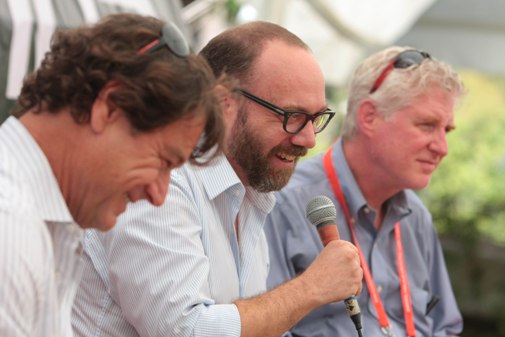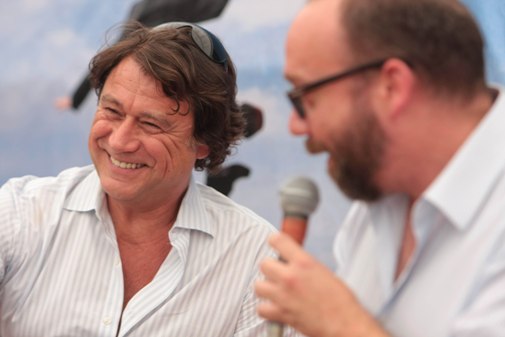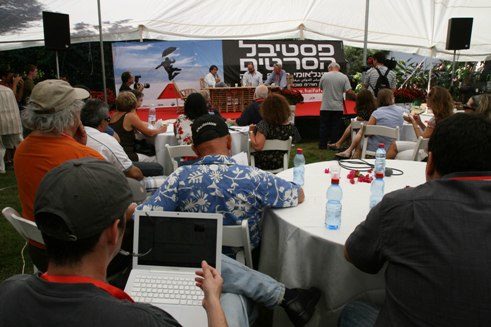
“Yeah, he’s a jerk,” says actor Paul Giamatti of Barney Panofsky, the picaresque Jewish anti-hero he portrays in Barney’s Version, producer Robert Lantos adaptation of the novel by Canadian author Mordechai Richler. Giamatti and Lantos have accompanied the film to the Haifa International Film Festival 2010, where they met with the press in the garden of the cinematheque. Responding to questions with blunt candor, a piercing gaze, and casual demeanor, Giamatti’s mix of eloquence and quirky humor make it easy to see how he imbues Barney with an irresistible appeal.
Life takes Barney from one absurd adventure to another, as he blunders through relationships with three very different wives (Rachelle Lefevre, Minnie Driver, and the exquisite Rosamund Pike), with Dustin Hoffman as his bizarre but loving ex-cop father, and Scott Speedman as his free-spirited best friend. “I like playing the character because he’s nothing like me,” said Giamatti, “he’s kind of aggressive and passionate and I’m boring and sedate. I don’t see a whole lot of similarities and I don’t want to – he’s not the nicest guy in the world.” Yet, following Barney over the course of his tumultuous life, one cannot help but become intensely involved with Barney and his story.

The film is a project born of a long-standing relationship – the friendship between producer Lantos and novelist Richler. It is the second adaptation of a Richler novel for Lantos who produced Joshua Then and Now in 1985. “The original plan was for him to write the screenplay,” said Lantos, but Richler died before he could write the screenplay. The adaptation went through five different writers, and reached completion, according to Lantos, because the last one, Michael Konyves, “ignored everything that I said.”
Part of the difficulty was due to the epic length of the novel. “It was twelve years of torture,” said Lantos, “one by one, things I loved [from the novel] had to go. The first cut of the film was three hours long.” In editing the film, “50 minutes of wonderful gems” ended up on the cutting room floor, which will, perhaps eventually find a place on the DVD version.
Although Lantos says that Barney’s Version is “about people who happen to be Jewish but it’s not a Jewish film,” the process of making the film had at least one characteristic Jewish aspect – where there are two Jews, you will have at least three opinions. Lantos shared with the press the film’s “Jewish existential crisis”: In the scene where Paul and Dustin go to visit the wife’s grave…there was a big debate about whether kippah’s should be worn or not. We didn’t all agree – secular Jews who don’t go to synagogue, and are not religious, would they wear a kippah or not at a cemetery?”
Giamatti said, “Dustin and I didn’ t think they would be wearing the kippahs, at least I was pretty sure that I wouldn’t be, I didn’t want to speak for him but he didn’t think that he would be wearing one either.”
They decided to resolve the dilemma by going the traditional route: consulting a rabbi. Or rather, several rabbis: “For about an hour and a half we called certain rabbis all over North America.”

“The first rabbi,” said Lantos, “was the rabbi I called and he said for sure you have to wear a kippah in a cemetery. It’s religion and your mother’s grave. Paul said that wasn’t necessarily the final answer and Dustin wasn’t sure either and wanted to call his rabbi in Los Angeles.”
They decided that they were not going to tell the rabbi who believes what, in order “not to prejudice the answer,” recounts Lantos, “and we put him on speakerphone. We said we have a private situation in a Jewish cemetery with his wife, his mother.” After they described the scene, the rabbi said that in his opinion kippahs should be worn. Lantos continued, “Dustin wasn’t really sure it was the answer he wanted and it wasn’t the answer Paul wanted. Dustin said, but you know rabbi he’s standing at his wife’s grave but he sees a girl at the next grave and she’s wearing a mini skirt and he’s really looking at her legs and his next line of dialogue is ‘I really need to get laid’. You really think I should be wearing a kippah? Well [said the rabbi] in that case it could be either way.”
Of course, the producer has the final word, Lantos concluded the story: “So I said ok, don’t wear a kippah I can always put it on in post-production or CGI and you’ll never know.”

Through all the ups and downs of Barney’s destiny, there is a sense of fun throughout the film, and even some in-jokes. Barney is a producer of what Lantos described as “schlock TV programs” and he cast prominent Canadian directors Atom Egoyan and David Cronenberg as the directors of those low-level flics. Said Lantos, “It was nice to have fun, it was my own way of indulging myself.” He told Egoyan and Kronenberg “We’re gonna make fun of you and do what you’re told.” Added Giamatti, “It was nice to be able to tell those guys to go to hell.”
Giamatti is a versatile actor who has portrayed different characters, both fictional and real, imparting a memorable presence in each performance. Initially a theatre actor, he recalled his first screen role as a stage hand, and described the odd feeling of film’s realism as opposed to the theatre when he realized he had to literally brush a real horse rather than creating the feeling of the moment. In comparing different roles, he said he is open to all types of films – “I’m happy to do anything” – even acting in front of a blue screen, which, in its reliance on the imagination he compares to the theatre, saying it “feels like you’re on stage again.”

AYELET DEKEL





